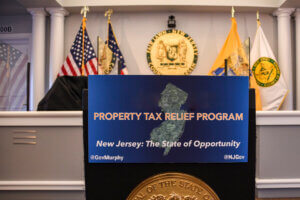A 5-state survey of coastal community residents (New York, New Jersey, Delaware, Maryland, Virginia)
This project was funded through federal grant from the National Oceanic & Atmospheric Administration.
SUMMARY
In June 2007, the Urban Coast Institute and the Polling Institute at Monmouth University embarked on a survey of residents in coastal communities along the Mid-Atlantic bight – from the southern shores of Long Island to the tip of the DelMarVa peninsula. The purpose of this survey is to further awareness of the Mid-Atlantic coast as an inter-related environment, and to assess similarities and differences among residents’ views of that coast.
The sample was divided into five coastal regions: New York East (Suffolk county), New York West (Nassau county), New Jersey North (Monmouth and Ocean counties), New Jersey South (Atlantic and Cape May counties), and DelMarVa (coastal portions of Delaware, Maryland, and Virginia. A total of 850 residents of coastal towns were interviewed.
– Coastal Community Life –
Mid-Atlantic coastal community residents report that the ocean is an important part of their lives, although many do not take full advantage of its amenities (such as swimming, boating or fishing).
Most residents (60%) indicate that living near the ocean is a very important part of their lives. Another 25% say it is somewhat important and 14% not important.
While most residents can often be found on the beach or walking the shoreline (58%) and many often go swimming in their local waters (41%), fewer residents regularly participate in fishing (20%) or boating (26%) activities.
The vast majority of coastal residents say that protecting the coast should be a high priority for their town. On a personal level, they are somewhat more concerned about housing affordability, followed by pollution and development. They are relatively less concerned about habitat loss, decline of marine-based industries, and fishery depletion.
Fully 3-in-4 residents say that protecting the coastal environment (76%) should be a high priority for their town. This is somewhat larger than the number who would give a high priority to improving education (67%), lowering taxes (66%), or controlling growth (54%).
A majority of Mid-Atlantic coastal residents are seriously concerned about housing affordability (71%), coastal pollution (59%), and the pace of development (58%) in their towns. Just under half are seriously concerned about declining fish populations (48%), loss of wetland habitats (47%), loss of small-scale marine industries (46%), and increasing risks from storms and sea level rise (45%). Fewer are worried about the need to revitalize coastal downtown areas (28%).
– The Coastal Environment –
Residents give generally favorable ratings to the health of their local coastal environment, but they are split on whether this has gotten better or worse in the last decade. They identify shoreline erosion and pollution as their biggest environmental concerns today.
Two-in-three residents say that their coastal shorelines (67%) and waters (64%) are in good health, but only about 1-in-7 would rate their health as “excellent”.
Mid-Atlantic coastal residents are split on whether their local coastal environment’s health has improved (27%), worsened (31%) or stayed the same (36%) over the past ten years.
Mid-Atlantic coastal residents are slightly more likely to expect that their local coast will get worse (34%) rather than better (26%) over the next ten years. Another 32% anticipate no change.
When asked to name the single most important environmental issue affecting their local coast, erosion/sea rise (39%) and pollution (35%) are the top two concerns mentioned, with the pace of development (10%) coming in third.
– Coastal Policy –
Mid-Atlantic coastal residents tend to give the government poor marks on protecting the environment. But they say they are willing to pay more in taxes in order to protect coastal waters, shorelines and beaches.
Just 4-in-10 say government has done a good job protecting coastal wetlands (43%) and keeping the waters clean (43%), 3-in-10 say it has done a good job reducing storm damage (32%) and managing marine life (31%), and 1-in-4 say it has done a good job managing coastal growth and development (26%).
Six-in-ten residents (60%) indicate they would support greater efforts to protect their local coasts even if it required tax increases. Only 27% oppose this.
Most Mid-Atlantic coastal community residents are convinced that coastal areas will be at a greater risk for flooding and damage from sea level rise in the next 25 years. In general, residents support the use of most preservation measures such as replenishing sand and building dunes (even if they obscure sightlines), but they draw the line at measures which may interfere with the rights of current property owners. There are also divisions in opinion on public and private rights and responsibilities in terms of who should control access to the waterfront and who should pay the cost of reducing coastal hazards.
About 2-in-3 residents (65%) acknowledge that sea level rise and flooding risk will increase substantially over the next 25 years. Only 27% feel that public reports of these risks have been exaggerated.
Majorities support a variety of measures for reducing risks from coastal hazards, including dunes and natural buffers (81%), beach replenishment (79%), public purchase of existing open space (78%), and jetty and seawall construction (76%). However, residents are less supportive of any policy that would allow government purchase of private homes in high risk areas (42%).
About half (48%) of Mid-Atlantic coastal residents say that government should carry most of the costs for any risk reduction projects, 24% say the burden should mainly be carried by coastal property owners, and 23% say that both government and property owners should share the costs equally.
Residents are split on who should have final say on waterfront access issues – affected property owners (41%) or the public interest (38%). Another 15% say both parties should have equal say in the matter.
In terms of using the oceans for energy production, a majority support placing wind farms off their local coast, even if the windmills are visible from the shoreline. However, they are less favorable toward drilling for oil or gas in the Atlantic Ocean.
71% of residents say that, in principle, they would support energy-generating windmills that are not visible from the shoreline. Support drops only slightly for visible wind farms – 57% would support this to 20% opposed and 21% who have no strong opinion either way.
On the question of drilling for oil or gas, only 33% of coastal residents would support this compared to 40% who are opposed and 24% who have no strong opinion.
– Regional Differences –
The survey also found some interesting regional differences of opinion among Mid-Atlantic coastal community residents.
New York:
New Yorkers tend to be the most positive about the current state of their coastal environment. Despite this, they are more likely than New Jersey residents to feel their coastal environment will worsen in the next ten years.
New Yorkers are twice as likely to name erosion/sea rise rather than pollution as their top environmental concern.
Residents of eastern Long Island are more positive than those in western Long Island about government performance on preservation efforts.
Western Long Island residents are among those most supportive of efforts to build natural buffers and manufactured barriers and replenish sand, while those in eastern Long Island are the most supportive of purchasing and preserving existing open space along the coast.
New Jersey:
New Jerseyans are the most likely to report seeing an improvement in their coastal environment over the past ten years.
While southern New Jerseyans are more likely to name erosion and sea rise as their number one concern, pollution is the top issue along the northern New Jersey coast.
Residents of southern New Jersey are more positive than those in northern New Jersey about current government preservation efforts.
DelMarVa:
Virginians tend to be the least positive about the current state of their coastal environment. DelMarVans in general are somewhat more likely than their northern Mid-Atlantic neighbors to feel their coastal environment has worsened in the past ten years.
Pollution is a bigger concern than erosion for DelMarVa residents.
DelMarVans tend to be less approving of government preservation efforts, except in the area of managing marine life.
The questions referred to in this report are as follows:
A. LIVING ON THE COAST
A 1.Do you own or rent this apartment or house?
A 2.Is this home a waterfront property right on the beach or bay, within a few blocks of the beach or bay, within one mile, within five miles, or farther away?
A 3.How much of the year do you live in this home – 10 to 12 months, 6 to 9 months, or less than 6 months?
A 4.How many years have you lived in this town, or have you lived here all your life?
B. COASTAL COMMUNITY ISSUES
B 1.Here are some issues that your town may have to deal with. After I read each one, please tell me whether it should be a high, medium, or low priority.
A. Improving public education
B. Controlling growth and development
C. Lowering taxes
D. Protecting the coastal and ocean environment
E. Reducing the risk to people and property from storms and other coastal hazards
B 2.How much does the following statement describe you: “The coast and ocean is an important part of my life”? Does this describe you a lot, some, not much, or not at all?
B 3.Thinking specifically about environmental issues in your area, what is the number one issue affecting the coastal and ocean environment in your area?
B 4.Please tell me if you think each of the following is a very serious, somewhat serious, not too serious, or not at all serious concern in your area?
A. Coastal and ocean water pollution
B. The loss of wetlands and coastal habitats
C. Sea level rise and increasing risk from storms
D. A decline in fish and shellfish populations
E. Housing is becoming less affordable
F. Small-scale marine and fishing industries are disappearing
G. The amount of development along the coast
H. The revitalization of traditional downtowns and business areas
B 5.Thinking about the coastal waters and bays in your area, would you rate their health as excellent, good, only fair, or poor?
B 6.Thinking about coastal habitats, beaches and natural shorelines in your area, would you rate their health as excellent, good, only fair, or poor?
B 7.Compared to ten years ago, would you say the condition of your local coastal environment has gotten better, gotten worse, or stayed about the same?
B 8.And looking ahead to ten years from now, do you think the condition of your local coastal environment will get better, get worse, or stay about the same?
C. COASTAL POLICY
C 1.How good a job is government doing at each of the following. Please respond with excellent, good, only fair, poor, or tell me if you don’t have an opinion on this.
A. Keeping coastal and ocean waters clean
B. Managing fish and other marine life
C. Protecting coastal wetlands and wildlife habitats
D. Protecting coastal property from storm damage
E. Managing growth and development in coastal communities
C 2.Would you support or oppose efforts to protect the coastal waters, shoreline, and beaches in your town if it meant you would have to pay more in local taxes?
C 3.Some reports predict that sea levels will rise substantially in the next 25 years and that many coastal areas will be in much greater risk from storm damage and flooding. Based on what you have heard, do you think that this risk is generally accurate, generally exaggerated, or generally underestimated?
C 4.How much do you favor each of the following as a way to preserve coastal habitats and reduce storm damage in your area – a lot, some, not much, or not at all?
A. Building bulkheads, jetties, seawalls and other hard structures
B. Creating sand dunes and other natural buffers
C. Replenishing sand when it is washed away
D. Public purchase of existing natural coastal areas for preservation
E. Public purchase of private homes located in high risk areas
C 5.Would you support or oppose building sand dunes and other natural features to protect your town’s beaches, property, and people if it meant ocean views would be restricted?
C 6.Who should pay for most of the cost for projects designed to reduce damage from storms and other coastal hazards – government OR coastal property owners?
C 7.C7. Now I’d like to ask you about access to waterfront areas or waterways adjacent to private property. When there is a dispute over how the public is allowed to gain access to these areas, who should have more say – residents who own the adjacent waterfront property OR government agencies representing the public interest?
Some people have proposed using coastal resources to help meet our energy needs.
C 8.Would you support or oppose placing electricity-generating windmills off your coast as long as they are NOT visible from the shoreline, or do you have no opinion either way?
8A.And would you support or oppose placing these windmills off your coast if you could see them in the distance, or do you have no opinion either way?
C 9.Would you support or oppose drilling for oil or gas in the ocean off the Atlantic coast, or do you have no opinion either way?
D. PERSONAL BEHAVIORS
D 1.I’m going to ask you about some activities people may do within five miles of their homes. In the past year, have you [READ ITEM] often, occasionally, rarely, or never?
A. Gone fishing, crabbing or clamming from a beach, pier or bulkhead
B. Gone fishing or crabbing on a boat in coastal waters
C. Taken a boat, canoe, kayak or jet-ski out for pleasure
D. Gone swimming or surfing
E. Gone sunbathing or walking along the shore or other natural area
D 2.Do you currently have flood and storm insurance for your home?
[ASKED OF THOSE WITH FLOOD INSURANCE COVERAGE:, n=480]
D 3.In the next ten years, do you think that you may have to either sell your home or drop flood insurance primarily because of the cost of that insurance?
E. DEMOGRAPHICS
Now just a few final questions so we can classify your answers —
E 1.E1. What was the last grade in school you completed?
E 2.E2. What was your age on your last birthday?
E 3.E3. How many people live in your household, including yourself?
E 3A.How many are children under the age of 18?
E 4.Are you of Latino or Hispanic origin?
E 5.Are you white, black or of Asian origin?
E 6.So that we can group all answers, is your total annual family income before taxes: Under $50,000; from $50,000 to just under $100,000; from $100,000 to just under $150,000; or $150,000 or more?
E 7.Respondent gender.
E 8.Regional Distribution (weighted):
Click on pdf file link below for full methodology and results by key demographic groups.




